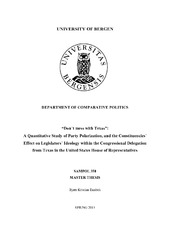| dc.description.abstract | Since the 1980s there has been a significant increase in polarization between the Republican and Democratic parties in the United States Congress. This thesis looks further into the increase in polarization in the United States House of Representatives. By using Texas as a case the thesis investigate if the congressional district affects the legislators' ideology, which again may explain the increasing polarization. This thesis addresses two schools of theories of polarization. First are the external theories, which are the redistricting-, ideological realignment-, constituent sorting-, economic- and party activism explanations. Second is the internal explanation that addresses changes at the inside of Congress. In addition research that address changes in Texas politically, economically and demographically is included. The different explanations have been intensely discussed among scholars of polarization, and an additional part of this thesis has been to test some of the external explanations. The data used is gathered from voteview.com, which estimate legislators' ideology, and the Almanac of American Politics, which provides detailed data from every congressional district. By using a Time-Series-Cross- Section design, the thesis clearly finds that there has been a significant increase in polarization between the Democratic and Republican parties. Another finding is that the Democratic and Republican legislators from Texas have traditionally been more conservative than the rest of the House of Representatives, but that this has equalized in the past congresses. By using three different regressions in two models, the thesis finds that the economic explanation is the more reliable of the external explanations used in this thesis. It also indicates that demography has a part to say. Still the polarization puzzle is too complex to be explained by one single explanation, and that the different explanations used in this thesis in varying degree contribute in explaining polarization. | en_US |
